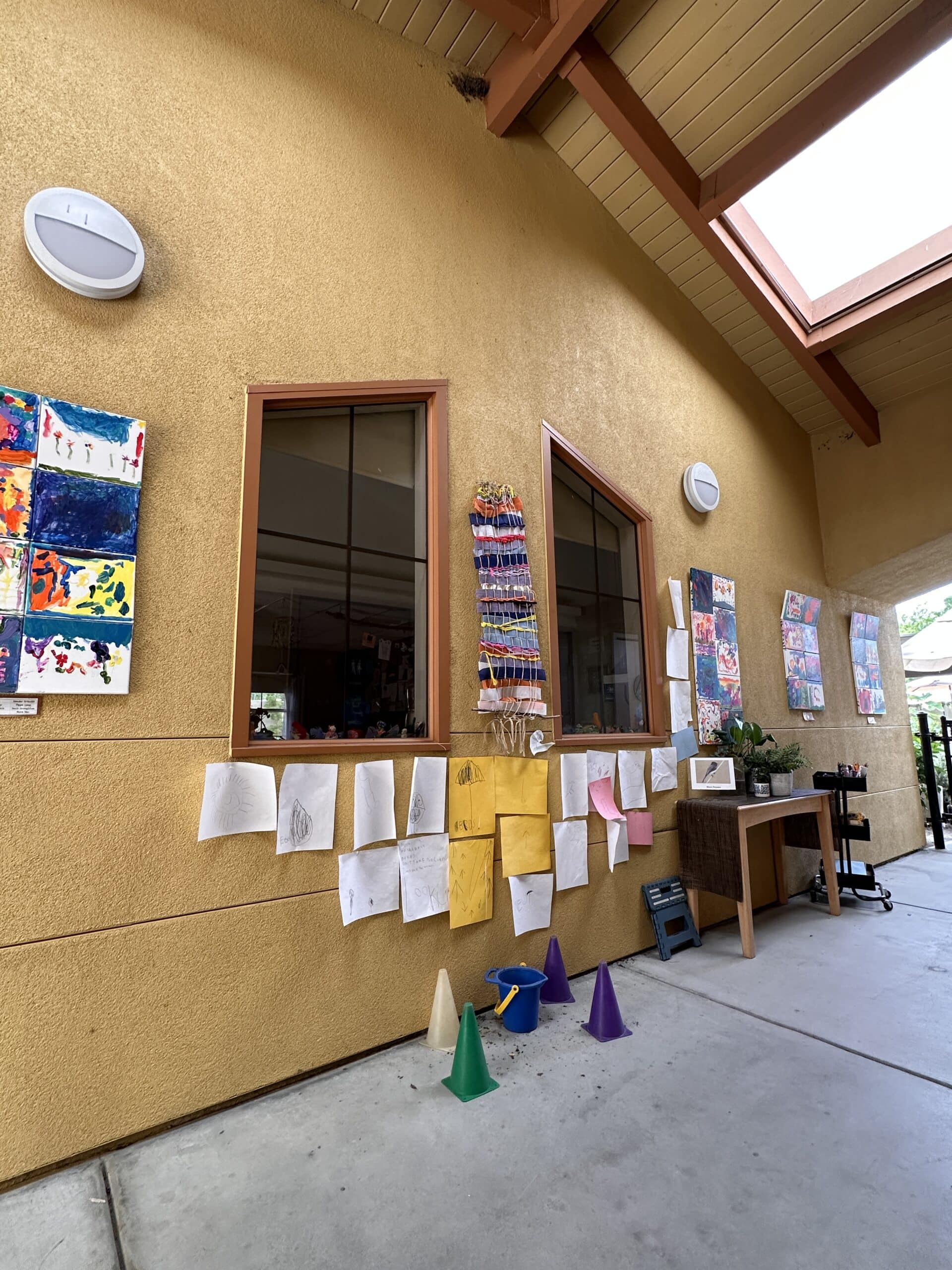 The black phoebes’ nest, with warning signs, cones, and a bucket to collect debris set up by the students.
The black phoebes’ nest, with warning signs, cones, and a bucket to collect debris set up by the students.
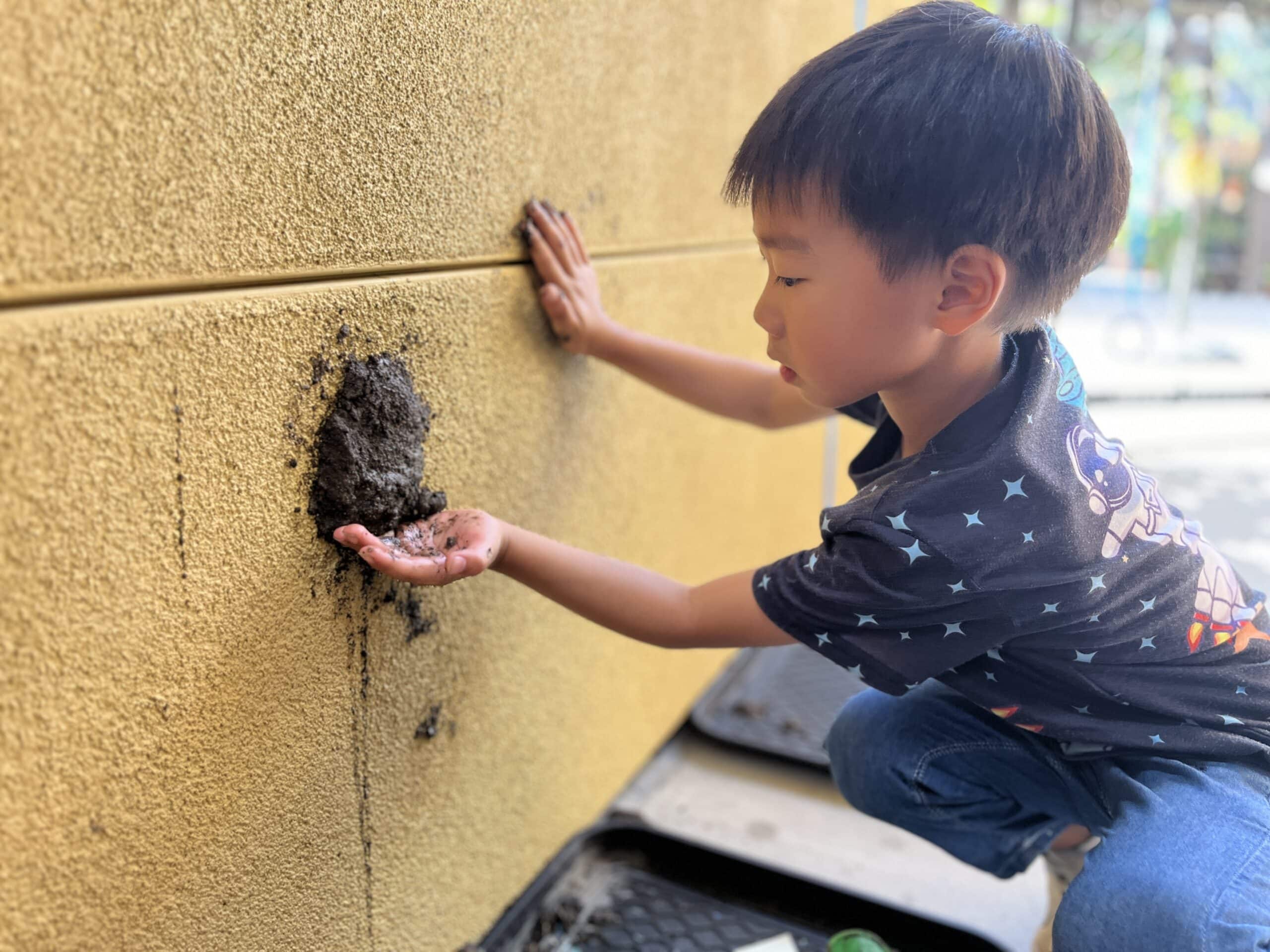
A student attempts to make a mud nest in order to better understand how the birds are able to build theirs.

A drawing of a black phoebe
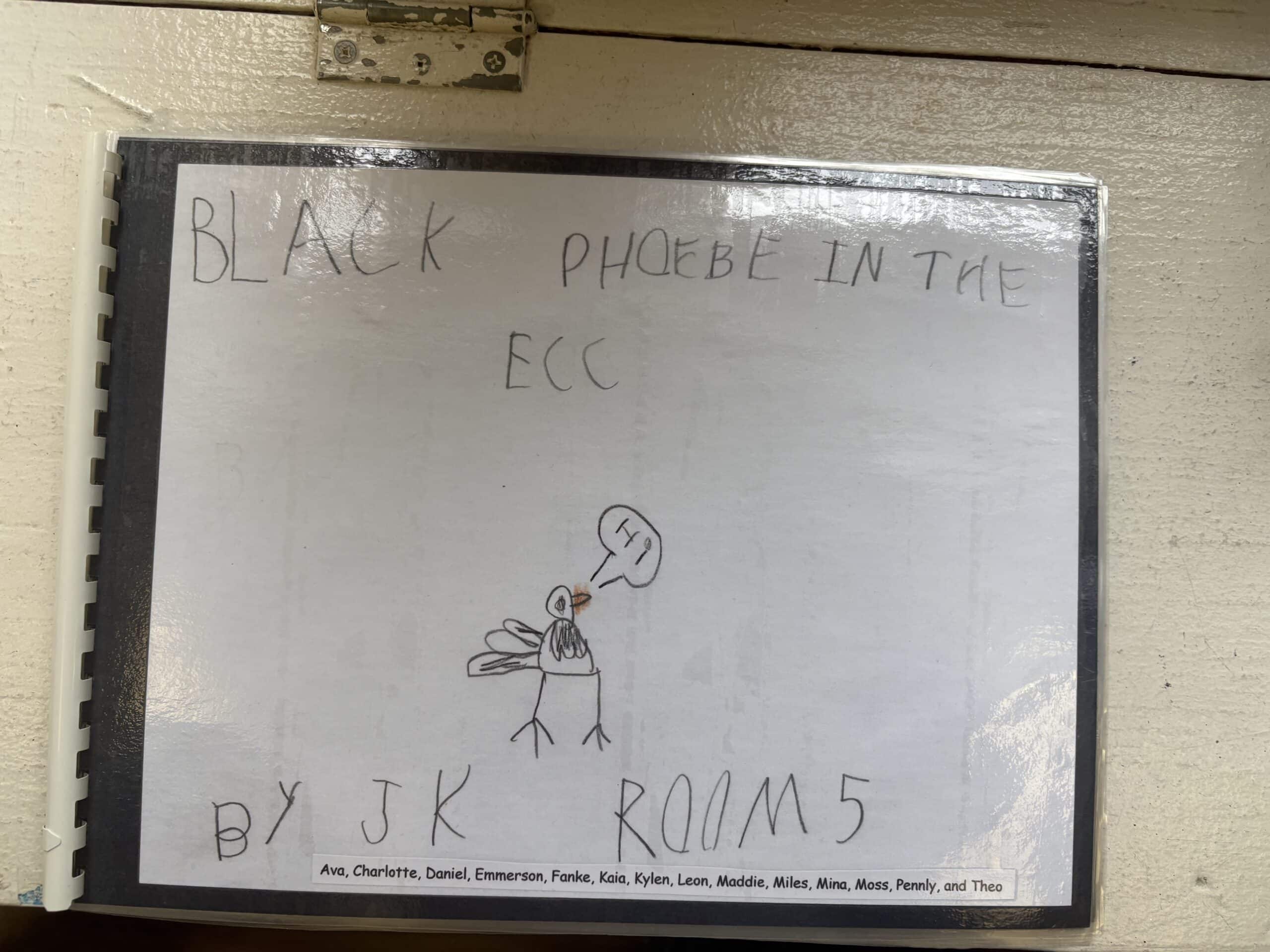
The cover

Page 1
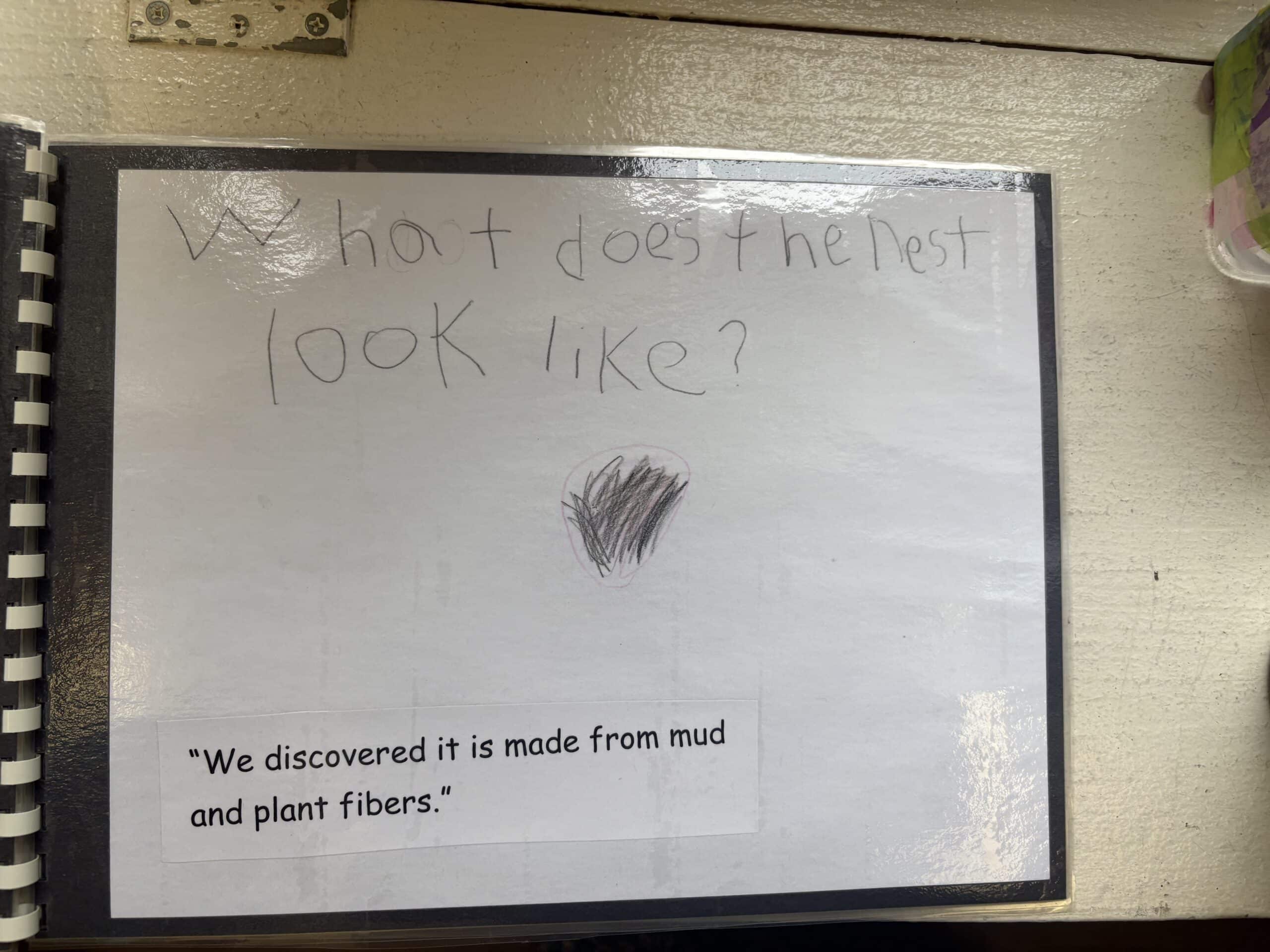
Page 2

Page 3
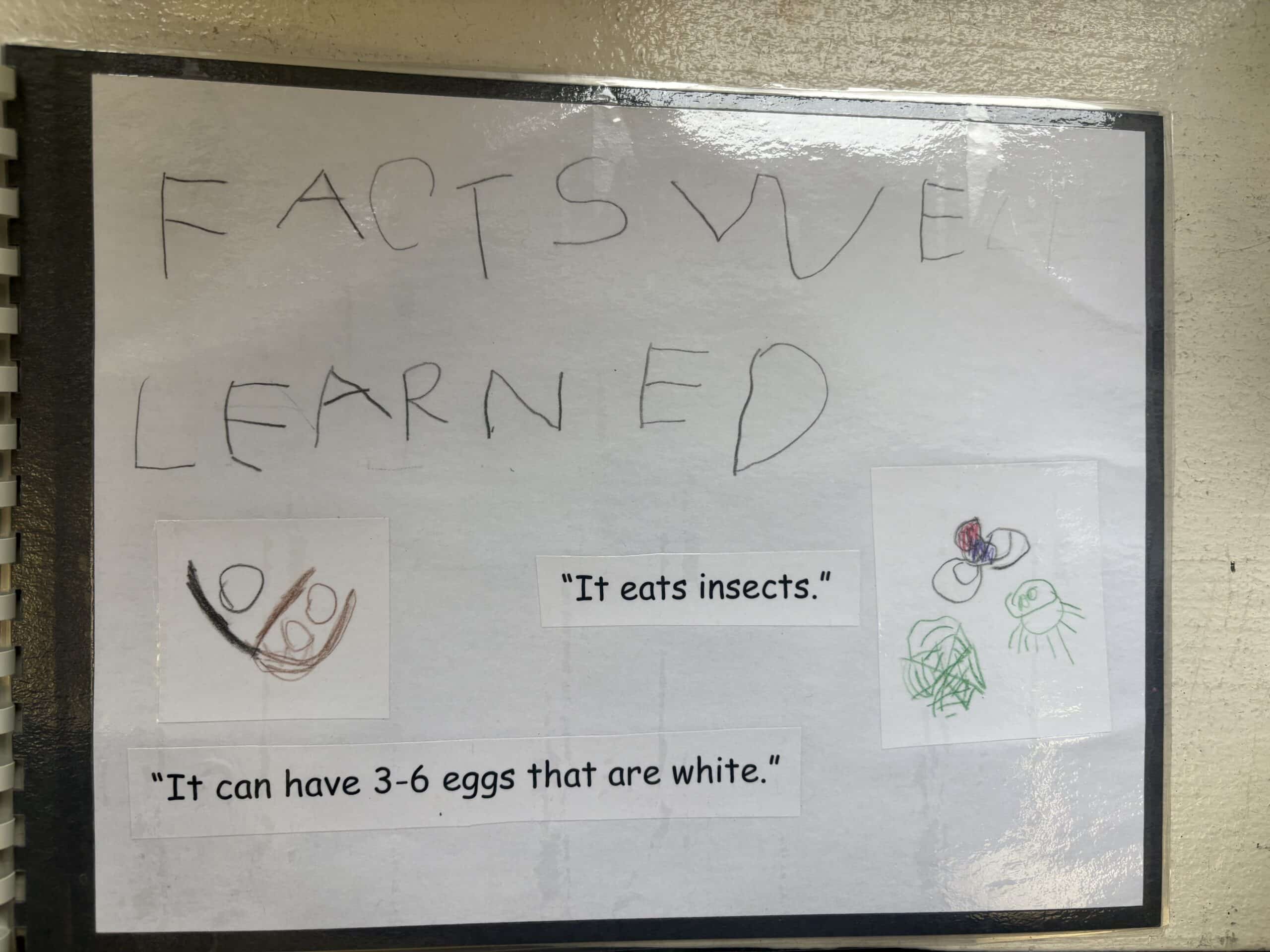
Page 4
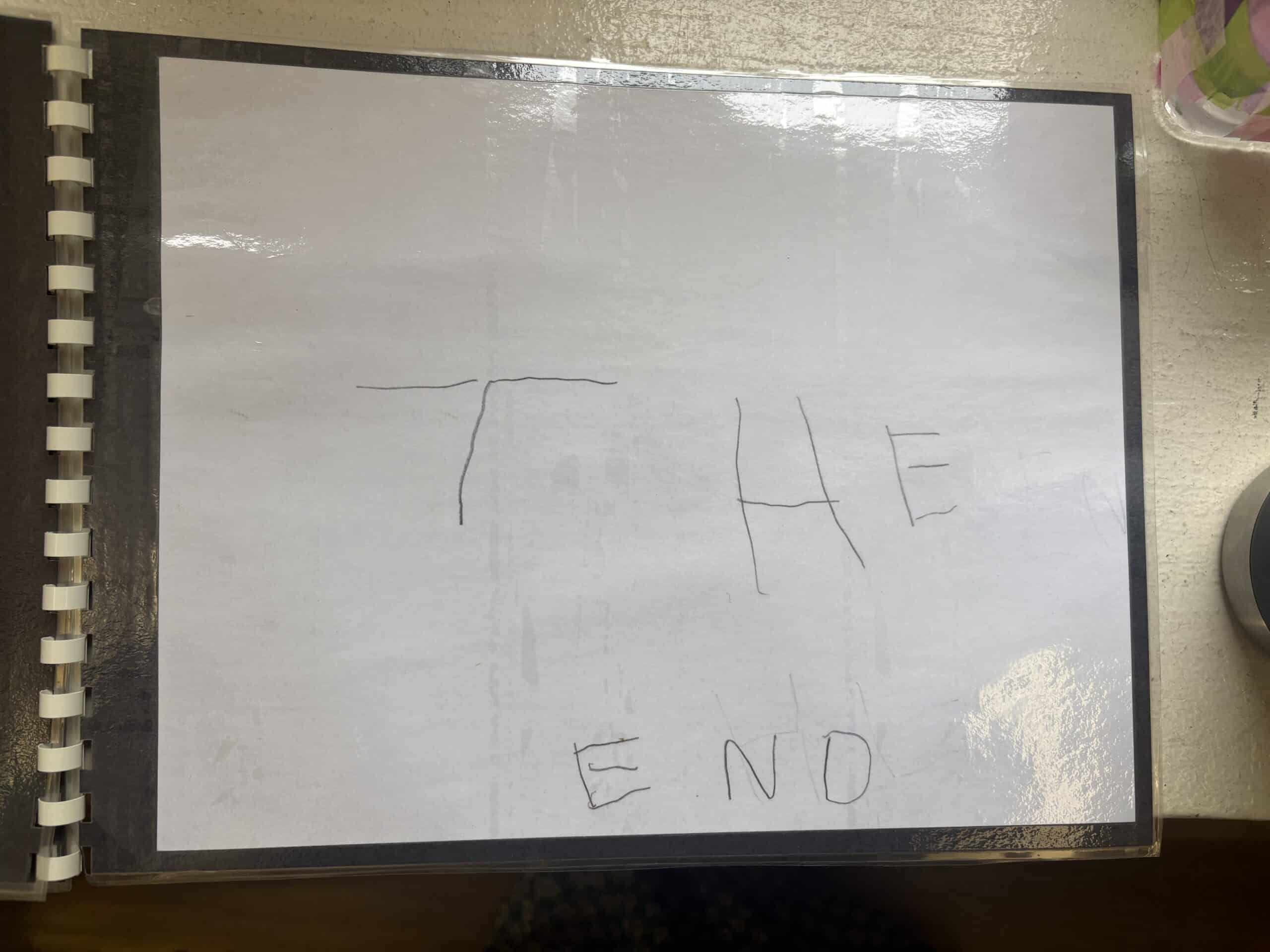
Page 5
Alec Patton:
So Maria, what are we looking at here?
Maria Curtis:
So we’re looking at a mud dwelling nest from the black phoebes, and they’ve been a part of this side of the building for a number of years now. They typically have a two or three broods a year, but since over the summer when we have the buildings tented, it disrupted their flow of using the little nest here and they decided to build a nest in our walkway.
Alec Patton:
And this nest is we’re on the outside of the building-
Maria Curtis:
Yes.
Alec Patton:
… it’s kind of a convenient nest spot for everybody, right here.
Maria Curtis:
Yes, yes.
Alec Patton:
Now we’re going inside the Early Childhood Center, we’re passing through the gates, so we’re still outdoors but it’s a little more central.
Maria Curtis:
Mm-hmm. It became much more noticeable when the children and the grown-ups were utilizing our outdoor classroom and our courtyard that the birds with their beaks filled with mud would come swooping in from the north, and then come in from the south and would start attaching the mud to the stucco high up in the walkway. Coming upon this, I thought, oh, this could be either a great opportunity for the children, or do I ask maintenance to come and knock it down?
Alec Patton:
This is High Tech High Unboxed, I’m Alec Patton, and you just heard me talking to Maria Curtis, Director of the Early Childhood Center at La Jolla Country Day School in California. The sound quality in that clip is a little rough because we were walking around the La Jolla Country Day campus. Maria was showing me how the teachers and students in junior kindergarten were responding to a challenge that every one of us faces, how to share our space with wild animals.
Specifically, a family of black phoebes had moved in next to their classroom. The black phoebe is a songbird, it’s actually a species of fly catcher and you can find them as far north as Oregon and as far south as Argentina. They build nests out of mud, and these nests stick very well to the walls of buildings. This can be a problem because one feature of many Southern California schools is that the line between indoor and outdoor is pretty fuzzy. The first nest that Maria and I looked at was clearly on the outside of the school, out of everybody’s way. But that nest had been abandoned and the birds were building their new nest in what was effectively a hallway in the junior kindergarten. As Maria said, the normal course of action was pretty obvious, call maintenance. So I asked her what made her hesitate.
Why not just knock it down?
Maria Curtis:
I saw this as a great opportunity to give them the chance to become experts of learning about black phoebes. They’re in the nature, they’re around the ECC all the time. I love birds, and I thought I’d share that with them. But just so that they can be inquisitive, they could be curious, that they can be a part of what could possibly become an inquiry project to study and to just understand their thinking about nature and how we live together.
Alec Patton:
So Maria wrote a letter to the junior kindergartners, most of whom at this point in the school year were four years old.
Maria Curtis:
“Dear junior kindergarten learners, I like your help to decide what we should do about two birds building their nest. They’re building it in the walkway, please come see what they are building with me. What should we do about the birds building their nest? Ms. Curtis.”
Alec Patton:
Kristin Owens junior kindergarten class was particularly primed for this question. I interviewed Kristin and Maria together to hear the rest of the story. And I want to note two things before we continue. First, the ECC is across the street from a fire station and something was clearly going on while we were doing this interview so you hear a bunch of sirens at a couple points. Second, there are a few spots where kids are mentioned by name we edited those, so the names are unintelligible. Here’s Kristin.
Kristin Owen:
We actually, in our classroom, had just finished an art project where we had made some clay birds that went along with a story that we were doing, and we were trying to find a way to display them in the room and just so happened to put them in the window underneath where the bird was making the nest. And so during our morning meeting, it just so happened the day that we didn’t know we were going to be getting the letter from Ms. Curtis, the black phoebe actually flew past our window and one of the kids noticed it fly by. And so we were kind of joking, saying, “Oh, wouldn’t it be fun if now the bird has some neighbors?”
And then one kids was wondering why the bird was out there. Someone had seen the bird before, so we of course had to go outside and see what was happening. And that kind of led to, oh, the bird is on the wall making the nest. And so then the letter came to us later that day, which then progressed into us then returning the letter and discussing what we wanted to do with the bird.
Alec Patton:
How did you go about deciding your response as a class?
Kristin Owen:
I read Ms. Curtis’s letter to the group, and then they immediately had all kinds of responses as to what we should do. So we wrote them all down and then compiled them into a letter for Ms. Curtis.
Alec Patton:
And can you read your letter?
Kristin Owen:
Sure.
“Dear Ms. Curtis, we received your letter and unanimously voted to keep the nest, listed below are our reasons why. [Inaudible 00:05:22] said, ‘I think we should leave it because then we would have a pet. And if they have babies, then we’ll have more pets like our fish. And we made clay birds that will be their neighbors.’ Another child said, ‘Because they are good for the earth and because every animal does something good for the earth.'[inaudible 00:05:40] said, ‘Leave them because they should be able to live.’ And then multiple children gave the answer, ‘Leave them because then they won’t have a place to live, and then they will have to make a new home and take their babies away. We really, really wanted to see those babies.’ We decided we want to learn more about the birds and asked Mr. Eaton, who is our school librarian, if he had any books about the black phoebe birds, but the library didn’t really have anything. We were wondering if you could help us find out some more information. Thank you. Best, ECC five.”
Alec Patton:
All right, so the stage is set now, what happened next?
Maria Curtis:
After I received the responses, I invited the children to come out into the walkway and not only did I have their responses written, I was able to hear their voices share their thoughts and their ideas, their deeper thinking, rather than just there being cute little kids that they were able to say no, that the birds deserve to live too. And they began that wonder of how does the nest get up there? And became more observant of the multiple times that the birds were flying in and out of the area.
And so I joined them at circle and I started to ask questions, “Well, what should we do? We’re going to keep the nest then how do we let people know that the nest is up there?” Because knowing black phoebes, it’s a mud nest, the area can become very muddy and dirty down below. And I said, “Well, when you see things that are being constructed, what do you notice?” And they said, “Well, we see signs.” And I said, “Okay, well we’ll need some signs, what do you think the sign should say?” And they’re like, “Birds. And there were arrows that we need to say to point to where the nest is and the bird’s name.” And so then I said, “Okay, and then what else should we have?” They said, “Well, we need cones to cone off the area.” And then somebody said, “Well, we need a bucket to collect things.”
And so they decided that they were going to create this area that was going to be sacred and informative to those who were coming by, that people who walked through would know that black phoebes were building their nest above. So, we provided the materials out in the playground, they collected the cones, they went to get the buckets, and we had the paper and the markers. I had images of what a black phoebe looked like and they started to do drawings from that one photo of the black phoebe. And they started to then want to display it on the stucco wall. So we provided the little sticky tape and they started to put it all underneath and that went on for several days where they were adding to it. And another class actually added some of their own drawings as well because they were inspired.
We saw that the children then when their parents would either drop them off in the morning or pick them up in the afternoon, would grab them by their hand and, come see, that excitement started to spread. So that was that piece of how they created this whole outdoor documentation of information that they had learned through their drawings and asking us how to spell certain words of, don’t take the buckets, don’t take the cones to protect.
Alec Patton:
And what were you doing with the buckets? Why did you need buckets?
Maria Curtis:
It was collecting the fibers in the mud that was dropping down as the little birds would come in and attach it to the stucco.
Alec Patton:
Right. And at some point you decided to write a book.
Maria Curtis:
We’re still in the process.
Alec Patton:
You’re still in the process.
Maria Curtis:
Mm-hmm.
Alec Patton:
And that was so that the library can have a reference about black phoebes?
Maria Curtis:
Mm-hmm.
Kristin Owen:
Correct.
Alec Patton:
And when I spoke to last, you were talking about doing experiments about affixing clay to the wall. Did that happen?
Kristin Owen:
It did. So first before we did that, we went on a specimen collection, we wanted to know what exactly were the materials that the black phoebe was using. And so with that bucket that was down below, they came out with clipboards, and paper, and a little bag to collect materials that we could further observe at our science table.
And in so doing, they noticed that it wasn’t just plants that were there, it was the fibers broken down from the plants that were on there, including the mud. Which then led us to talking about, well, where do you think that the black phoebe was getting the mud? And so as a group, they decided it had to be close by and so they picked three areas that they thought the black phoebe was possibly getting the mud from. The garden, the mud kitchen, and there is a plant area on the playground by one of the walls that they did.
So we broke the children up into three groups and they collected mud from those different areas to see which one might possibly stick. Well, we did ask permission first from Ms. Curtis, who gave us the all clear that we could section off an area on the stucco wall below where the black phoebe was making it to see which mud would work better, how it would work. And so the following day they worked in teams and had to figure out if they just put the mud on the wall, was it actually going to stick? And they realized that it wasn’t, that they needed to add something to it, which was water.
And it was interesting watching the three groups, how some took handfuls of the mud and dipped it in the water and tried sticking it on. Some realized that they needed to soak it, so poured the water into it and mixed it, made a mixture. And then a third group who wasn’t quite sure how to get the water to mix with the mud, and so it took a little more investigating and talking through the process for them to figure out. Because some were just taking little sprinkles and sprinkling it on and realized that that wasn’t quite working. We let it dry and wanted to see which one withheld and withstood being able to stay up on the wall.
Alec Patton:
What’d you find?
Kristin Owen:
All three did. But the group that added the water to it and mixed it together, that had more of a solid base to it. That stuck better to the wall.
Alec Patton:
In November, Kristin came into her classroom one morning to find a dead bird, a black phoebe. She thinks it must have wandered in the classroom and got trapped over the weekend. Sometimes being neighbors with a school can be dangerous to birds no matter how hard the humans try to be welcoming.
Maria and Kristin, understandably didn’t share this with the students. Remember, this is a class of four-year-olds. But they’re pretty sure the bird Kristin found was the one building the nest. In any case, no birds were working on the nest anymore, Maria and Kristin improvised in order to keep the project going.
Maria Curtis:
So I was thinking, how do we make this into a math activity? How can we graph? How can we help children be observant in the environment? So I said, “Kristin, what if we take photos of the areas that the children see the most as they walk across campus, as they go to the gym?” Because we know that black phoebe’s like to be up high to catch the little bugs. Where would they be perching?
And so I thought if we take photos and then I have a little bird stamp that I got from Amazon, so that as they’re walking around campus, that when they come back to class that they could stamp where they see the black phoebes at. So not only would it become a math that they could do graphing, then we can start to think more about, well, why do we think they’re over in this area? What could be there that really attracts them and keeps them there? Are we noticing any other nests on the building? So that’s going to be the next step.
Alec Patton:
Then in the spring, something big happened.
Maria Curtis:
There’s two birds that have returned to the same start of the little mud nest. So we first started to see little bits of mud and fiber on the table, and we looked up and they returned. And so we started to see them swoop in and out of the walkway again. And then sighted them on the gates and then the trees, which really excited the children because they weren’t around. They were probably in other parts of the campus, but then now they’re back on this area.
Alec Patton:
With all this renewed energy, Kristin reminded the class that at the start of the year, they had been planning to write a book for Mr. Eaton, the librarian, to add to the library.
Kristin Owen:
We threw out to the kids, “Hey, we had kind of talked about all the things that we had learned and how Mr. Eaton didn’t have any information. Do you think we could make a book for Mr. Eaton?” And they were unanimously, “Yes, we can.” And one by one threw out ideas of all the different things that we had learned about it. And once we kind of got an idea of how to organize the book one by one, they had the choice to either write words in it or do illustrations, and every child wanted to do something for the book. And once it started coming together, they were just over the moon excited and so, so proud of their work and couldn’t wait. Anybody who came in and saw bits and pieces of it, they just couldn’t wait to share what was their part in putting this together.
Alec Patton:
We’re going to finish this episode with a recording of the class, presenting their book to Mr. Eaton, including a reading of the book by Mr. Eaton himself. Enjoy.
Kristin Owen:
Well, Mr. Eaton, we have enjoyed you reading us stories earlier, but what do we have?
Speaker 7:
We have a book for you.
Mr. Eaton:
Really? Oh my goodness.
Speaker 8:
It’s about black phoebes.
Kristin Owen:
So remember at the beginning of the year we came in here looking for information about the black phoebe, but unfortunately, the library didn’t have what we needed or were looking for. So, after a year long investigation of the black phoebe, dun, dun, dun-
Mr. Eaton:
Oh my goodness.
Speaker 9:
That’s the front cover that I made.
Mr. Eaton:
That is incredible.
Speaker 9:
I made that part. I made the front covers.
Mr. Eaton:
This is so cool.
Speaker 9:
And then the rest was made from other people [inaudible 00:16:30]. I made some parts and then other people made the other parts.
Mr. Eaton:
It’s got everyone’s name on it.
Speaker 9:
Yeah.
Mr. Eaton:
Is it okay if I read this?
Kristin Owen:
Oh, yes. Please.
Mr. Eaton:
Have you guys heard this before?
Speaker 7:
Yes.
Mr. Eaton:
Okay. Is it okay if I read it again?
Speaker 7:
Yeah.
Mr. Eaton:
This is called Black Phoebe in the ECC.
Speaker 10:
Hi.
Mr. Eaton:
By JK Room 5.
Speaker 10:
Hi.
Mr. Eaton:
And it says, hi. Oh, this is great.
Speaker 10:
I did that part.
Mr. Eaton:
“What does the black phoebe look like? It is black and some brown with a white tummy and yellowish beak.”
This is fantastic.
“What does the black phoebe sound like?” Ooh, it makes this sound.
Speaker 11:
Oh yeah, you just have to scan the barcode.
Mr. Eaton:
Oh my goodness, this is technologically advanced.
Speaker 9:
You might need to do it from behind.
Mr. Eaton:
Okay, hold on.
Speaker 4:
That’s my page.
Speaker 12:
That’s my [inaudible 00:17:27].
Speaker 4:
See, now you can always listen to it.
Mr. Eaton:
Oh, that’s so cool. I love it.
Speaker 4:
Now you can share with other kids.
Mr. Eaton:
I can. I think I might have to show this to Ms. Owens class.
Speaker 4:
And you even need a barcode so you can scan it.
Mr. Eaton:
“What does the nest look like? We discovered it is made from mud and plant fibers.” It’s still in the same spot?
Speaker 13:
Now it made another house.
Mr. Eaton:
I love it.
Speaker 13:
[inaudible 00:18:00].
Mr. Eaton:
I like these bubble letters. “Where have we found the black phoebe? In the ECC hallway.”
Speaker 14:
I made that one.
Mr. Eaton:
Outside the ECC gate. The JK garden fence. You have the JK playground. Oh, on top of the kindergarten building.
Speaker 15:
I drew that. I drew the two-
Speaker 7:
[inaudible 00:18:22].
Speaker 15:
… on the playground at the field.
Mr. Eaton:
Oh. “Facts we learned, it eats insects.”
Speaker 15:
It lays three to six eggs.
Mr. Eaton:
Well, I hope it doesn’t eat [inaudible 00:18:38]. “It can have three to six eggs that are white.” Very cool.
Speaker 16:
I wrote that.
Mr. Eaton:
“The end.” That’s incredible. You should all give yourselves a big round of applause because that is… And I will applaud you guys as well because this is incredible. Are you guys okay if I read this to other JK classes?
Speaker 7:
Yes.
Mr. Eaton:
Okay, cool.
Alec Patton:
High Tech High Unboxed is hosted and edited by me, Alec Patton. Huge thanks to Maria Curtis, Kristin Owen, Rafa Eaton, and everybody in the ECC, and to the black pheobes of course. You can find a link to photos from the project, including images from the book in the show notes. Thanks for listening.
TAGS:



